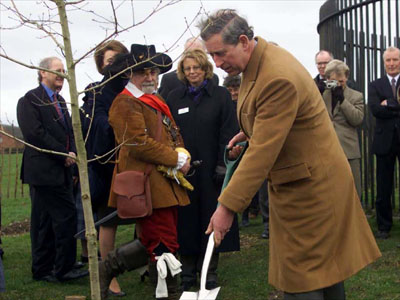
Prince Charles plants a small oak at Boscobel, watched by a
Royalist English Civil war reenactor from The Sealed Knot.
First Foot Guards
Royalists
rejoice!
May 29th
is Oak Apple
Day
The
Royal Oak
By Graeme Marsden
Wear an oak leaf in your lapel (or on your hat) on this day to celebrate King Charles II's escape from the Roundheads after the disastrous Battle of Worcester in 1651.
In 1664 (after the Restoration) the King’s birthday of 29th May was designated Oak Apple Day by Act of Parliament, and a special service was inserted in the Book of Common Prayer. For over 200 years the King’s birthday was celebrated by wearing a sprig of oak leaves in remembrance of the event. The tradition is no longer observed, although hundreds of inns and public houses throughout the country are still called ‘The Royal Oak’ and many Royal Navy ships have proudly borne the name.
What is an Oak Apple?
Click
Oak Galls & Ink
Click
King Charles
and the Oak
Click
Royal Oak Heraldry
Click
The Royal Navy
Click
Pubs & Inns
Click
Click here to see a picture
of the Royal Oak, today. It is not the original tree, but a descendant. In 2001,
Prince Charles planted another oak sapling in memory of the escape of his namesake.
Click

Prince Charles plants a small oak at Boscobel,
watched by a
Royalist English Civil war reenactor from The Sealed Knot.
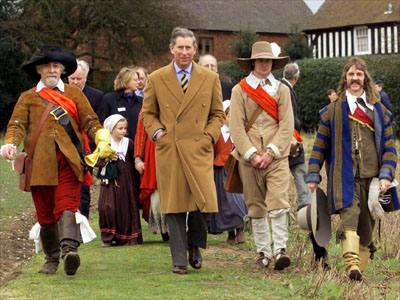
Prince Charles, accompanied by other Royalist
soldiers.
An oak apple is a gall or tumor formed on the leaf as a defense against attack from a small gall wasp such as Biorhiza pallida. The gall is a sphere from 1/2" to 2" in diameter, which can be found in on European oak trees.

On galls, hynke, and old records.
When I lived in London I gathered oak galls on Wimbledon Common, with which to make ink. The formula came from a recipe in the Tower of London collection (temp Henry VIII).
It is a good encaustic ink (called "Hynke" in the recipe), made from crushed oak galls (which supply a source of tannic and gallic acids), green vitriol crystals (ferrous sulphate) , gum arabic and water.
Apparently the ink becomes a solution of ferrous gallate and ferrous tannate, which when absorbed by the paper that you write on, undergoes an oxidation process. It cannot be erased (hence 'encaustic' - it 'burns in' to the paper).
Many old records were written in such inks, especially parish records. Sometimes the ink can fade a little with age. If you've ever searched original parish registers you can see where old researchers (from way back!) have added a solution of oxgall, which temporarily restores the script. Disastrously, the oxgall over time forms stains that totally obliterate the text!
Two years after the execution of his father, King Charles, age 21 and uncrowned, landed in Scotland from France. He was crowned at Scone, raised an army and marched south to defeat Cromwell’s Commonwealth Army and restore the monarchy.
Charles met the Commonwealth Army at the royalist town of Worcester on 3rd September 1651. Cromwell’s army was victorious, capturing the town and leaving the royalist forces of the King with hundreds of dead and wounded. The King with Lord Derby, Lord Wilmot, and others, escaped and rode north to seek shelter at the royalist safe houses of Whiteladies Priory and Boscobel House, which were deep in Brewood Forest on the borders of Shropshire and Staffordshire.
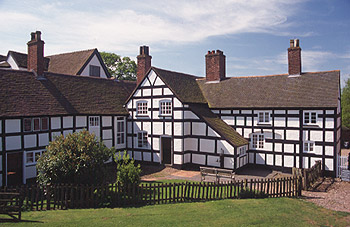
Boscobel House, where Charles hid, is a beautiful
half-timbered house.
Parliament put a reward of Ł1000 on the king's head, and the penalty of death for anyone caught helping him. In six weeks of narrow escapes the King managed to leave England, only returning at the Restoration in 1660.
His concealment in the Royal Oak at Boscobel is the most well-known story of this time.
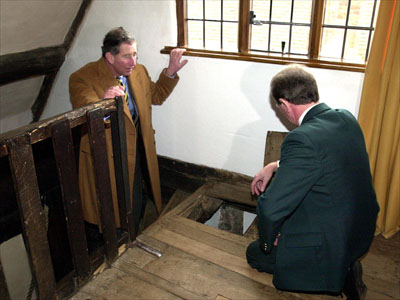
Prince Charles (left) is shown one of the
hiding places ("priest holes") at Boscobel House.
The King was escorted from Worcester by the owner of Boscobel House, Charles Giffard, who was assisted by the Pendrill family. Richard Pendrill disguised the King in the rough clothes of a woodman. His hair was cut and his face and arms stained to resemble a countryman. They attempted to escape to Wales, but all the bridges across the river severn were guarded by Commonwealth troops, and they were forced to return. At Boscobel House they met Colonel Carlos, who was one of the last royalists to escape from Worcester and had led the final royalist charge.
At dawn it became urgent to conceal the King and Colonel Carlos because Commonwealth troops were already searching the woods nearby. The King and Carlos spent an uncomfortable day in a nearby oak tree and the next night hidden in a secret hiding place in Boscobel House. Thereafter the Giffard and Pendrill family were able to assist the King's flight to France.
When the King returned to England in 1660, he granted annuities and gifts to the Pendrill brothers for their services. They were summoned to Whitehall Palace to attend the King and did so for a number of years. In 1675 permanent pensions were bestowed on the Pendrills, and to this day is being paid to their descendants.
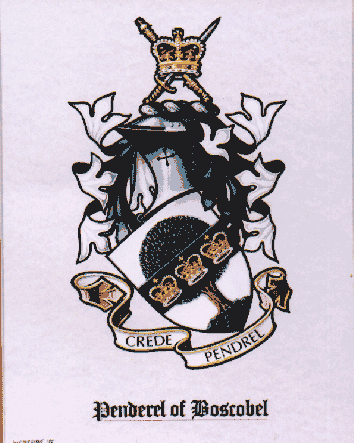
For those who assisted the King in the Royal Oak, a new coat of arms was devised. The arms of Colonel Carlos contained an oak tree and three royal crowns. The Giffard family retained their age-old coat of arms, and the Pendrill family was honoured with the same arms as those awarded to Colonel Carlos, but with a silver field and black fesse. The Pendrill crest (above the shield) is further distinguished by a royal crown encircling the crossed sword and scepter.
Ever since the restoration
there have been ships bearing
the proud name "The Royal Oak".
One such was built during the WWI and sunk in Scapa Flow by U-Boat ace Gunther Prien. The ship went down with over 800 sailors.
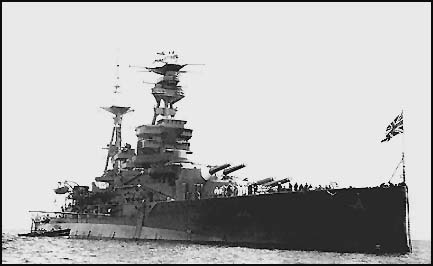
See the memorial
website
Click
Hearts of Oak
"Hearts of oak are our men, hearts of oak are our ships, we'll always
be ready." Memorable lines from the chorus of this old sea song. The tune
is well known today, and is often played by the First Foot Guards Musick. The
idea of the Royal Oak, of course sustained this
notion of toughness in adversity.
Today there are hundreds of public houses, inns and hotels that bear the name 'The Royal Oak".in the sign-painting tradition, there are still many inn signs that have no words. A simple picture of an oak and a crown is enough to elicit the words 'royal oak' to an Englishman.
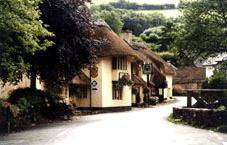
The Royal Oak at Winsford in Somerset (southwest
England).
… or even a Welshman:
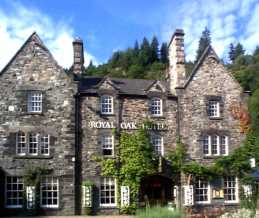
Pictured is the Royal Oak in picturesque Betws-Y-Coed (pronounced 'betts-a-coyd") in Wales, which is an absolutely captivating town, and a charming old coaching inn. I have stayed there myself, and swilled many a pint of the landlord's best nut-brown ale!
So if you're a British regimental reenactor, take the time to gather your oak leaves, and wear them proudly. Now you know the story behind this enduring royal symbol!
Go to
First Foot Guards
home page
Click